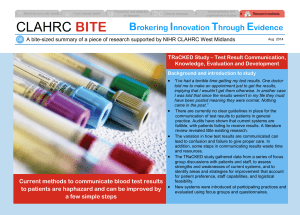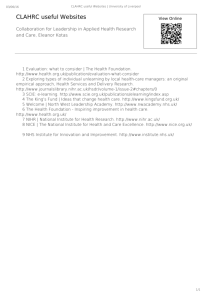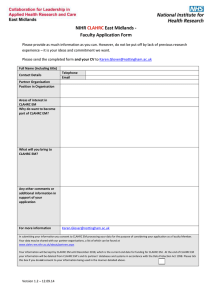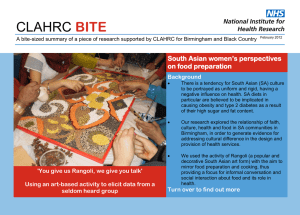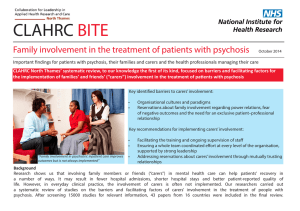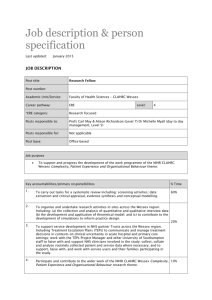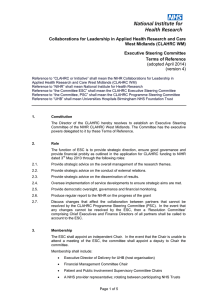CLAHRC BITE B
advertisement
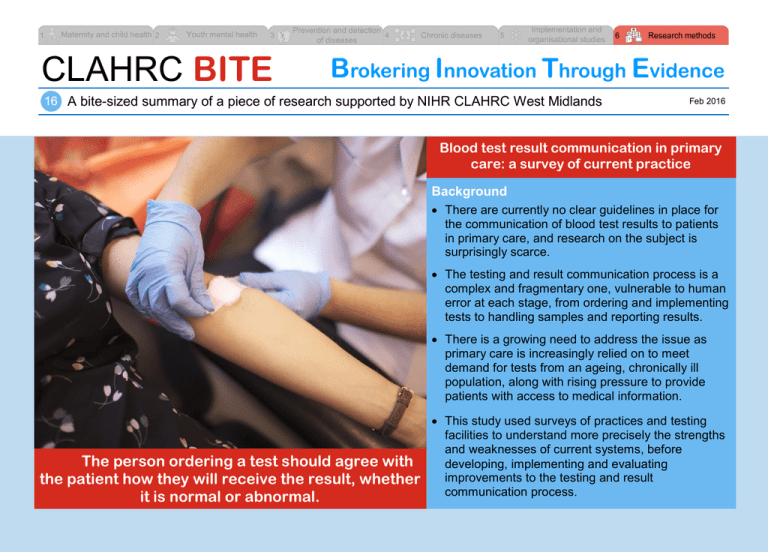
CLAHRC BITE Brokering Innovation Through Evidence 16 A bite-sized summary of a piece of research supported by NIHR CLAHRC West Midlands Feb 2016 Blood test result communication in primary care: a survey of current practice Background There are currently no clear guidelines in place for the communication of blood test results to patients in primary care, and research on the subject is surprisingly scarce. The testing and result communication process is a complex and fragmentary one, vulnerable to human error at each stage, from ordering and implementing tests to handling samples and reporting results. There is a growing need to address the issue as primary care is increasingly relied on to meet demand for tests from an ageing, chronically ill population, along with rising pressure to provide patients with access to medical information. The person ordering a test should agree with the patient how they will receive the result, whether it is normal or abnormal. This study used surveys of practices and testing facilities to understand more precisely the strengths and weaknesses of current systems, before developing, implementing and evaluating improvements to the testing and result communication process. Findings Researchers produced a ‘service blueprint’ identifying potential sources of delay and error in the testing and result communication process, such as mistakes in the sampling, labelling or sample identification procedures. Where results were normal, 98% of practices required patients to contact the surgery, but patients are frequently unaware of their responsibility in result communication. 40% of practices also expected patients to contact them in the case of abnormal results. Many practices had no system to detect whether a blood test had been returned by the lab, and would be unaware of a missing result until a patient call. None of the practices surveyed had a member of staff allocated to ensure that abnormal results were returned to patients. Practices appeared unaware and/or ill-equipped to detect errors, despite existing technological safeguards in the clinical management software used by the majority of practices surveyed. This work has led to 4 publications and 2 editorials. See BITE 8: Litchfield IJ, Bentham LM, Lilford RJ, Greenfield SM. Test result communication in primary care: clinical and office staff perspectives. Fam Pract. 2014;31(5):592-7 [http://goo.gl/jn49u0] Reference Litchfield I, Bentham L, Lilford R, McManus RJ, Hill A, Greenfield S. Test result communication in primary care: a survey of current practice. BMJ Quality & Safety. 2015; 24:691-699 [http://goo.gl/Cv5cPJ] Recommendations for Practice Local health economies need to do more work to address the gaps in the test result communication process exposed by this research, and develop governance structures to ensure test results are communicated in a timely manner regardless of outcome. What is NIHR CLAHRC West Midlands? The NIHR Collaboration for Leadership in Applied Health Research and Care (CLAHRC) is a partnership between universities (Birmingham, Warwick and Keele) and a number of health and social care organisations in the West Midlands. We are funded by the National Institute for Health Research with a mission to undertake high-quality applied health research focused on the needs of patients to improve health services locally and beyond. The research is funded by the National Institute for Health Research. The views expressed are those of the author and not necessarily those of the NHS, the NIHR or the Department of Health.
